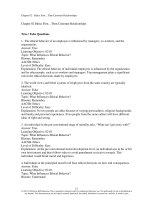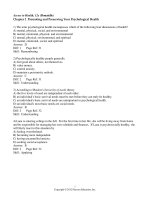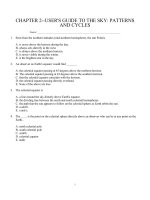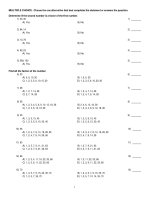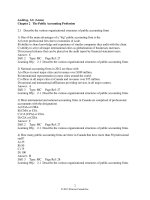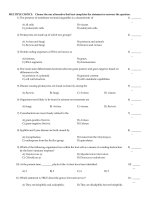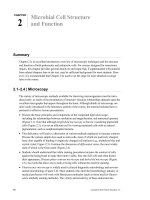Foundations of astronomy 12th edition seeds test bank
Bạn đang xem bản rút gọn của tài liệu. Xem và tải ngay bản đầy đủ của tài liệu tại đây (297.58 KB, 17 trang )
CHAPTER 2—A USER'S GUIDE TO THE SKY
MULTIPLE CHOICE
1. In one way of naming stars, a ____ letter indicates its brightness relative to the other stars in the
constellation.
a. English
b. Arabic
c. Greek
d. Cyrillic
ANS: B
PTS: 1
2. A constellation must consist of a number of stars, all
a. at the same distance from the Earth.
b. at various different distances from the Earth.
c. within a boundary in the same general angular area of the sky.
d. Wrong! Constellations are made of planets only.
ANS: C
PTS: 1
3. Most of the constellations in use today originated in ____ mythology.
a. Greek.
b. Middle Eastern
c. Both answers (a) and (b)
ANS: C
PTS: 1
4. The names of stars usually come from
a. ancient Arabic.
b. ancient English.
c. Latin.
d. Russian.
e. Chinese.
ANS: A
PTS: 1
5. ____ is the brightest star in the constellation of Ursa Majoris.
a. Ursa Majoris
b. Ursa Majoris
c. Ursa Majoris
d. Wrong! Ursa Majoris is the name of the brightest star.
ANS: C
PTS: 1
6. The magnitude scale
a. originated just after the telescope was invented.
b. can be used to indicate the apparent intensity of a celestial object.
c. is used to measure the temperature of a star.
d. was used to determine the rate of precession.
ANS: B
PTS: 1
7. The apparent visual magnitude of a star is 7.3. This tells us that the star is
a.
b.
c.
d.
one of the brighter stars in the sky.
bright enough that it would be visible even during the day.
not visible with the unaided eye.
very close to Earth.
ANS: C
PTS: 1
8. The apparent visual magnitude of a star is a measure of the star's
a. size.
b. intensity.
c. distance.
d. color.
e. temperature.
ANS: B
PTS: 1
NARRBEGIN: Table 02-01
Table 2-1
Star
Name
Apparent Visual
Magnitude
Dra
Cet
Per
Nim
CMa
3.07
2.53
3.98
8.07
1.46
NARREND
9. Which star in Table 2-1 would appear the brightest to an observer on Earth?
a. Cet
b. CMa
c. Nim
d. Per
e. Dra
ANS: B
PTS: 1
10. Based on the information in Table 2-1, what is the ratio of the intensity of Dra to that of Nim?
a. 2.512
b. 5
c. 8.07
d. 11.14
e. 100
ANS: E
PTS: 1
11. Which star in Table 2-1 would not be visible to the unaided eye of an observer on Earth?
a. Cet
b. CMa
c. Nim
d. Per
e. Dra
ANS: C
PTS: 1
12. The star Vega has an apparent visual magnitude of 0.03, and the star HR 4374 has an apparent visual
magnitude of 4.87. It has been determined that both stars are at the same distance from Earth. What
does this information tell us about the two stars?
a. Vega must be closer to Earth than HR 4374.
b. Vega must be farther from Earth than HR 4374.
c. Vega must produce less energy than HR 4374.
d. Vega must produce more energy than HR 4374.
e. Vega will appear fainter to us than HR 4374.
ANS: D
PTS: 1
13. Polaris is a second magnitude star, and Phi Pegasi is about 16 times fainter than Polaris. What is the
approximate magnitude of Phi Pegasi?
a. 18
b. 14
c. 3
d. 3
e. 5
ANS: E
PTS: 1
14. Star A has an apparent visual magnitude of 13.4, and star B has an apparent visual magnitude of 15.4.
Star A is ____ than star B.
a. 2 times fainter
b. 2 times brighter
c. 6.3 times fainter
d. 6.3 times brighter
e. 29.8 times fainter
ANS: D
PTS: 1
15. Seen from the northern latitudes, the star Polaris
a. is never above the horizon during the day.
b. always sets directly in the west.
c. is always above the northern horizon.
d. is never visible during the winter.
e. is the brightest star in the sky.
ANS: C
PTS: 1
16. An observer on Earth's equator would find
a. Polaris directly overhead.
b. Polaris 40 above the northern horizon.
c. that the celestial equator coincides with the horizon.
d. the celestial equator passing directly overhead.
e. that the ecliptic coincides with the horizon.
ANS: D
PTS: 1
17. The celestial equator is
a. a line around the sky directly above Earth's equator.
b. the dividing line between the north and south celestial hemispheres.
c. the path that the sun appears to follow on the celestial sphere as Earth orbits the sun.
d. a and b.
e. a and c.
ANS: D
PTS: 1
18. The ____ is the point on the celestial sphere directly above any observer.
a. north celestial pole
b. south celestial pole
c. zenith
d. celestial equator
e. asterism
ANS: C
PTS: 1
19. An observer in the Northern Hemisphere watches the sky for several hours. Due to the motion of
Earth, this observer notices that the stars near the north celestial pole appear to move
a. counter clockwise.
b. clockwise.
c. from left to right.
d. from right to left.
e. nearly vertically upward.
ANS: A
PTS: 1
20. You live at a latitude of 73 N. What is the angle between the northern horizon and the north celestial
pole?
a. 73
b. 27
c. 17
d.
e. 5
ANS: A
PTS: 1
21. You live at a latitude of 39 S. What is the angle between the southern horizon and the south celestial
pole?
a. 45
b. 23.5
c. 39
d. 51
e. The answer depends on the day of the year.
ANS: C
PTS: 1
22. You live at a latitude of 28 N. What is the angle between the northern horizon and the north celestial
pole?
a. 62
b. 28
c. 40
d.
e. 5
ANS: B
PTS: 1
23. You live at a latitude of 16 S. What is the angle between the southern horizon and the south celestial
pole?
a. 74
b. 164
c. 16
d.
e. 5
ANS: C
PTS: 1
24. You live at a latitude of 32 N. What is the angle between the southern horizon and the sun at noon at
the vernal equinox?
a. 45
b. 23.5
c. 32
d. 58
e. 81.5
ANS: D
PTS: 1
25. You live at a latitude of 61 N. What is the angle between the southern horizon and the sun at noon at
the summer solstice?
a. 52.5
b. 23.5
c. 61
d. 29
e. 5.5
ANS: D
PTS: 1
26. You live at a latitude of 17 N. What is the angle between the southern horizon and the sun at noon at
the winter solstice?
a. 17
b. 23.5
c. 96.5
d. 73
e. 49.5
ANS: E
PTS: 1
27. If the north celestial pole appears on your horizon, what is your latitude?
a. 90 N
b. 90 S
c. 0
d. 45 N
e. The latitude of the observer cannot be determined from the information given.
ANS: C
PTS: 1
28. What is the approximate latitude of the observer in the diagram below?
a.
b.
c.
d.
e.
90 N
90 S
50 N
50 S
0
ANS: C
PTS: 1
29. What is the approximate latitude of the observer in the diagram below?
a.
b.
c.
d.
e.
20 N
20 S
70 N
70 S
0
ANS: B
PTS: 1
30. An observer in the Northern Hemisphere takes a time exposure photograph of the night sky. If the
illustration depicts the photograph taken by the observer, which direction was the camera pointing?
a.
b.
c.
d.
e.
straight north
straight east
straight south
straight west
straight up, directly overhead
ANS: C
PTS: 1
31. An observer in the Northern Hemisphere takes a time exposure photograph of the night sky. If the
illustration depicts the photograph taken by the observer, which direction was the camera pointing?
a.
b.
c.
d.
e.
straight north
straight east
straight south
straight west
straight up, directly overhead
ANS: D
PTS: 1
32. An observer in the Southern Hemisphere takes a time exposure photograph of the night sky. If the
illustration depicts the photograph taken by the observer, which direction was the camera pointing?
a.
b.
c.
d.
e.
straight north
straight east
straight south
straight west
straight up, directly overhead
ANS: C
PTS: 1
33. An observer in the Southern Hemisphere takes a time exposure photograph of the night sky. If the
illustration depicts the photograph taken by the observer, which direction was the camera pointing?
a. straight north
b. straight east
c. straight south
d. straight west
e. straight up, directly overhead
ANS: B
PTS: 1
34. An observer in the Northern Hemisphere takes a time exposure photograph of the night sky. If the
illustration depicts the photograph taken by the observer, which direction was the camera pointing?
a.
b.
c.
d.
e.
straight north
straight east
straight south
straight west
straight up, directly overhead
ANS: A
PTS: 1
35. An observer in the Southern Hemisphere takes a time exposure photograph of the night sky. If the
illustration depicts the photograph taken by the observer, which direction was the camera pointing?
a.
b.
c.
d.
e.
straight north
straight east
straight south
straight west
straight up, directly overhead
ANS: D
PTS: 1
36. What causes summer here in the northern hemisphere? In the summer, at this point
a. the Earth is closer to the sun.
b. the Earth's northern hemisphere is tilted toward the sun.
c. the Earth's northern hemisphere is tilted away from the sun.
ANS: B
PTS: 1
37. When it is winter in the northern hemisphere, it is ____ in the southern hemisphere.
a.
b.
c.
d.
winter
summer
spring
fall
ANS: B
PTS: 1
38. The sun moves ____ along the ecliptic among the stars.
a. eastward
b. westward
c. The sun does not appear to move.
ANS: A
PTS: 1
39. Which of the following causes seasons on the earth?
a. the earth being closer to the sun during our summer and farther during our winter
b. the sun's varying light output
c. the tilt of the earth's axis
d. the eleven-year sunspot cycle
ANS: C
PTS: 1
40. The summer solstice (at the start of summer) is the point on the ecliptic where the sun
a. crosses the celestial equator moving north.
b. crosses the celestial equator moving south.
c. is farthest north of the celestial equator halting its northward movement.
d. is farthest south of the celestial equator halting its southward movement.
ANS: C
PTS: 1
41. At the time of the winter solstice (the start of winter) the sun is
a. farthest south of the celestial equator.
b. farthest north of the celestial equator.
c. on the celestial equator moving north.
d. on the celestial equator moving south.
ANS: A
PTS: 1
42. As seen from the earth, the sun appears to move ____ along the ____ among the stars.
a. eastward, celestial equator
b. westward, celestial equator
c. eastward, ecliptic
d. westward, ecliptic
e. Wrong! The sun does not appear to move among the stars.
ANS: C
PTS: 1
43. At the time of the winter solstice (the start of winter) the sunlight is at a lower angle and thus is ____
than(as) in the start of summer.
a. less intense
b. more intense
c. the same intensity
ANS: A
PTS: 1
44. Precession of the rotation axis of Earth is caused by
a.
b.
c.
d.
e.
the force of gravity from the sun and moon on Earth's equatorial bulge.
the force of gravity from Neptune and Jupiter on the Earth-moon system.
the magnetic field of Earth.
the formation and subsequent melting of glaciers during the ice-ages.
the impact of asteroids.
ANS: A
PTS: 1
45. Precession of the rotation axis of Earth takes ____ to complete a cycle.
a. 24 hours
b. one year
c. 260 years
d. 26,000 years
e. 260,000 years
ANS: D
PTS: 1
46. The inclination of the axis of the earth varies from 22 to 24 degrees taking ____ to complete a cycle.
a. 24 hours
b. 1 year
c. 499 years
d. 41,000 years
e. Wrong! The Earth's axis tilt is fixed at exactly 23.50 with no variation whatsoever.
ANS: D
PTS: 1
47. The elliptical shape of the Earth's orbit varies with time and takes about ____ to complete a cycle.
a. 24 hours
b. one year
c. 26 years
d. 260 years
e. 100,000 years
ANS: E
PTS: 1
48. In the Milankovitch theory, the elliptical shape of the Earth's orbit, its axis tilt, and axis precession
vary with time. These combined at times to create ____ on Earth.
a. day and night
b. seasonal temperature variations
c. daily temperature variations
d. ice ages
e. the constellations
ANS: D
PTS: 1
49. Does the appearance of the constellations follow a seasonal pattern?
a. No, all of the constellations are on any clear night of the year.
b. Yes. As the year progresses, the constellations move to different areas of the sky.
c. Yes, during a winter night all the constellations you can see are different from the ones
that appear during a summer night.
d. Yes, during a summer night many of the constellations you can see are different from
those you can see on a winter night. However, there are some constellations that are
visible all year long.
ANS: D
PTS: 1
50. Which of the following statements correctly describes the relationship between stars and the modern
boundaries of constellations?
a. Only stars close to the ecliptic (the Earth's orbital plane) are located in constellations.
b. Every star is located in a constellation.
c. Only the brighter stars are in constellations.
d. Only those stars that were visible to the ancient Greeks are located in constellations.
ANS: B
PTS: 1
51. How much of the night sky is north of the celestial equator?
a. Less than one-half, because of the tilt of the equator to the ecliptic plane.
b. More than one-half, because of the precession of the poles.
c. Exactly one-half.
d. All of the night sky.
ANS: C
PTS: 1
52. If you point toward the zenith right now and then point there again 6 hours later, you will have pointed
twice in the same direction relative to
a. your horizon.
b. the Sun.
c. the Moon.
d. the fixed stars.
ANS: A
PTS: 1
53. If an observer walks north toward increasing latitude, the number of circumpolar stars would
a. remain constant.
b. decrease.
c. increase.
d. Unknown unless you also state the longitude of the observer.
ANS: C
PTS: 1
54. If you were standing on the Earth's equator, which of the following points in the sky would pass
through your zenith at some time during one full day (24 hours)?
a. The north celestial pole
b. The summer solstice
c. The vernal equinox
d. The ecliptic pole
ANS: C
PTS: 1
55. If the Sun passes directly overhead on at least one day per year, then
a. you are at or within
latitude of the equator.
b. you are at or within
latitude of the equator.
c. you must be exactly on the equator.
d. you could be anywhere because this occurs at least once per year at any location on the
Earth.
ANS: A
PTS: 1
56. In Brazil, the longest period of daylight occurs during the month of
a. December.
b. March.
c. September.
d. June.
ANS: A
PTS: 1
57. If you are standing at the Earth's North Pole, which of the following would be located at the zenith?
a. The nadir
b. The star Vega
c. The celestial equator
d. The north celestial pole
ANS: D
PTS: 1
58. For stars in the same constellation they
a. probably formed at the same time.
b. must be part of the same cluster of stars in space.
c. must have been discovered at about the same time.
d. may actually be very far away from each other.
ANS: D
PTS: 1
59. During the month of June the north celestial pole points approximately toward Polaris but during the
month of December it points
a. far north of Polaris.
b. far south of Polaris.
c. towards the star Vega.
d. towards the star Thuban.
e. still towards Polaris.
ANS: E
PTS: 1
60. If the Earth's period of rotation doubled, but the period of revolution stayed the same
a. the night would be twice as long.
b. the night would be half as long.
c. the year would be half as long.
d. the year would be twice as long.
e. the length of the day would be unchanged
ANS: B
PTS: 1
61. A sketch of the Earth with its north and south poles and equator is shown. The zenith is located in the
sky over your head if you are at...
a. Earth's equator
b. Earth's North Pole
c. Earth's South Pole
d. any of these
ANS: D
PTS: 1
62. During one day and night in the mid-northern hemisphere, the stars near the north celestial pole...
a.
b.
c.
d.
rise in the east.
set in the west.
circle the north celestial pole counter-clockwise.
circle the north celestial pole clockwise.
ANS: C
PTS: 1
63. As seen from the Earth's southern hemisphere, the celestial equator passes...
a.
b.
c.
d.
north of overhead.
south of overhead.
through the north celestial pole.
through the south celestial pole.
ANS: A
PTS: 1
64. At the Earth's north pole, the north celestial pole is directly overhead and stars near the horizon travel
in straight lines...
a. straight up from the horizon
b. straight up from the horizon slanting toward the right
c. straight up from the horizon slanting toward the left
d. parallel to the horizon
ANS: D
PTS: 1
65. The vernal equinox is the point on the sky where the sun crosses the ____________ going north and
east..
a. north celestial pole
b. south celestial pole
c. celestial equator
d. horizon
ANS: C
PTS: 1
TRUE/FALSE
1. The Greeks created all the constellations.
ANS: F
PTS: 1
2. A second magnitude star in Ursa Major is brighter than a fourth magnitude star in Orion.
ANS: T
PTS: 1
3. The Greek-letter plus constellation designation conveys information about a star's location and
brightness.
ANS: T
PTS: 1
4. Hipparchus devised the magnitude system in the late 1700's.
ANS: F
PTS: 1
5. The moon and visible planets are always within a few degrees of the ecliptic.
ANS: T
PTS: 1
6. Polaris has always been the star nearest the north celestial pole.
ANS: F
PTS: 1
7. The celestial equator always passes directly overhead.
ANS: F
PTS: 1
8. The celestial equator always crosses the horizon at the east point and west point.
ANS: T
PTS: 1
9. Navigators can find their latitude by measuring the angle from the northern horizon to the north
celestial pole.
ANS: T
PTS: 1
10. Precession of Earth's axis causes the date at which perihelion of Earth's orbit occurs to slowly change.
ANS: T
PTS: 1
11. A 3rd magnitude star is 3 times brighter than a 1st magnitude star.
ANS: F
PTS: 1
12. As Earth rotates, circumpolar stars appear to move counterclockwise around the north celestial pole.
ANS: T
PTS: 1
COMPLETION
1. Star A has an apparent visual magnitude of 6.3 and star B has an apparent visual magnitude of 5.3.
Star A is ____________________ times ____________________ than star B.
ANS: 2.5, fainter
PTS: 1
2. The ____________________ is the point on the celestial sphere directly above an observer, regardless
of where the observer is located on Earth.
ANS: zenith
PTS: 1
3. ____________________ is a measure of the light energy that hits one square meter in one second.
ANS: Intensity
PTS: 1
4. ____________________ is the point in Earth's orbit when Earth is closest to the sun.
ANS: Perihelion
PTS: 1
5. Earth's rotation axis ____________________ slowly so that in a few thousand years Polaris will no
longer be the North Star.
ANS: precesses
PTS: 1
6. Which planets are never visible near the eastern horizon at sunset?
ANS:
Mercury and Venus
Mercury & Venus
Venus and Mercury
Venus & Mercury
PTS: 1
ESSAY
1. What information does a star's Greek-letter designation convey?
ANS:
Answer not provided.
PTS: 1
2. Describe the path that a star on the celestial equator follows from the time it rises until it sets for
a.
a person at a latitude of 60 N.
b.
a person at the equator.
ANS:
Answer not provided.
PTS: 1
3. Describe the location of Polaris in the sky relative to the horizon as seen by observers in Alaska (lat. =
60 N), Texas (lat. = 33 N), Ecuador (lat. = 0), and Australia (lat. = 30 S).
ANS:
Answer not provided.
PTS: 1
4. How are the celestial poles and equator defined by Earth's rotation?
ANS:
Answer not provided.
PTS: 1
5. Why isn't the winter solstice the coldest day of the year?
ANS:
Answer not provided.
PTS: 1
6. Give two reasons why summer days are warmer than winter days.
ANS:
Answer not provided.
PTS: 1
7. For a mid-northern hemisphere observer, why can neither Venus nor Mercury ever remain visible
throughout the night as the full moon does?
ANS:
Answer not provided.
PTS: 1
8. What causes precession and why does it “move” the celestial equator among the stars?
ANS:
Answer not provided.
PTS: 1
9. Describe how a small change in the relative distance of Earth from the sun at perihelion could affect
the formation of glaciers on Earth.
ANS:
Answer not provided.
PTS: 1
10. Describe the evidence that best supports the Milankovitch hypothesis.
ANS:
Answer not provided.
PTS: 1
11. What advantage is there in referring to a star by its Greek-letter designation and constellation name
rather than using its traditional name alone?
ANS:
Answer not provided.
PTS: 1
12. How is a constellation different from an asterism?
ANS:
Answer not provided.
PTS: 1
